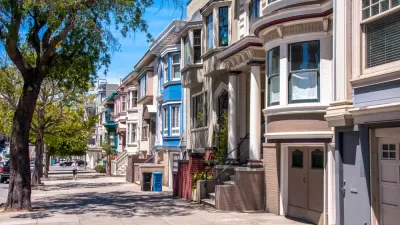Many families cannot afford to live in San Francisco, where housing prices are high and houses fit for families raising children are hard to come by.

One side effect of the high cost of housing in San Francisco is that it’s pushing families out of the city. "San Francisco notoriously has the smallest percentage of kids — 13.4 percent — of any city in the nation. But while San Francisco officials sweat and bicker over affordable housing, they rarely talk about family housing," reports Heather Knight for the San Francisco Chronicle.
Supervisor Norman Yee commissioned the city's planning department to come up with a report on the issue, and the results paint a grim picture for families. "Of all the homes across San Francisco with three or more bedrooms, just 30 percent of them are occupied by families with children. Many of them are inhabited by unrelated roommates, couples whose kids are grown or single people," writes Knight. The kind of demand that has families competing with singles that would break them up points to an extraordinary demand for housing of many kinds, Yee feels the problem is caused, in part, by what developers wish to build. "Yee said he’s tired of seeing plans for high-rises filled with studios and one-bedroom apartments and open spaces that are clearly designed for adults," Knight writes. It's also the case that there's simply a great deal of demand, some of which may be due to Yee and others opposing dense low-income developments.
FULL STORY: SF housing shortage leaves little room for families

Trump Administration Could Effectively End Housing Voucher Program
Federal officials are eyeing major cuts to the Section 8 program that helps millions of low-income households pay rent.

Planetizen Federal Action Tracker
A weekly monitor of how Trump’s orders and actions are impacting planners and planning in America.

Ken Jennings Launches Transit Web Series
The Jeopardy champ wants you to ride public transit.

Rebuilding Smarter: How LA County Is Guiding Fire-Ravaged Communities Toward Resilience
Los Angeles County is leading a coordinated effort to help fire-impacted communities rebuild with resilience by providing recovery resources, promoting fire-wise design, and aligning reconstruction with broader sustainability and climate goals.

When Borders Blur: Regional Collaboration in Action
As regional challenges outgrow city boundaries, “When Borders Blur” explores how cross-jurisdictional collaboration can drive smarter, more resilient urban planning, sharing real-world lessons from thriving partnerships across North America.

Philadelphia Is Expanding its Network of Roundabouts
Roundabouts are widely shown to decrease traffic speed, reduce congestion, and improve efficiency.
Urban Design for Planners 1: Software Tools
This six-course series explores essential urban design concepts using open source software and equips planners with the tools they need to participate fully in the urban design process.
Planning for Universal Design
Learn the tools for implementing Universal Design in planning regulations.
Ada County Highway District
Clanton & Associates, Inc.
Jessamine County Fiscal Court
Institute for Housing and Urban Development Studies (IHS)
City of Grandview
Harvard GSD Executive Education
Toledo-Lucas County Plan Commissions
Salt Lake City
NYU Wagner Graduate School of Public Service





























